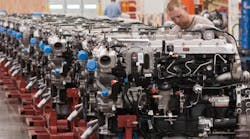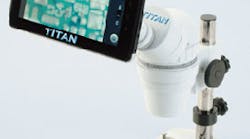Boeing has chosen GE Aircraft Engines and Rolls-Royce to supply two engine types for its forthcoming commercial aircraft design, the Boeing 7E7 Dreamliner. Boeing calls the 7E7 "an airplane that will provide the world's airlines with exceptional efficiency and environmental performance." It said the choice of the two engines is based on the results of several months collaboration with the top commercial airplane engine designers.
The 7E7 program is due to get underway this year. Boeing says it’s receiving encouraging customer support for the new plane and already has submitted firm contract proposals to airlines. It will be a family of three plane designs: the base model will carry 217 passengers in three seating classes and a flying range of 8,500 nautical miles (15,700 km.) A shorter-range 7E7 will carry 289 passengers in two seating classes and travel up to 3,500 nautical miles (6,500 km), and a stretch-version 7E7 will carry 257 passengers in three classes up to 8,300 nauticals miles (15,400 km.)
"The General Electric and Rolls-Royce engines will enable the 7E7 to fly higher, faster, farther, cleaner, quieter and more efficiently than comparable airplanes," said 7E7 senior vice president Mike Bair. "Having an engine choice is a key consideration for our customers. We're now offering two excellent options for the 7E7."
The 7E7 is seen decreasing fuel consumption, and the accompanying exhausts, by 20% versus comparably sized current designs. The engines themselves will help reduce airplane noise significantly, and meet new noise-control requirements on the airlines.
The two engines are the General Electric GENX and Rolls-Royce Trent 1000. Both engines will be able to provide 55,000-70,000 lbs. of thrust, and either design will be applicable to each of the three 7E7 models that Boeing plans.
The GE Next Generation (GENX) engine is derived from the ultra-high-thrust GE90 model, already proven in twin-engine aircrafts. The GENX will have composite fan blades, the highest pressure-ratio compressor in aviation, and a single-annular combustor where compressed air and fuel are mixed, to lower emissions. It will have its first full-engine test in 2006. Design and testing will be done at GE Transportation's headquarters in Evendale, OH, and assembly will be done in Durham, NC.
Rolls-Royce’s contribution to the 7E7, the Trent 1000, will be a new, fifth variant of its high-thrust Trent engine series. It will have the Trent three-shaft design layout, and Rolls predicts "it will be the most efficient and environmentally advanced Trent ever built."
Both engines will use the same standard interface with the airplane so they are entirely interchangeable, a first in commercial aircraft design. Boeing says the interchangeability will make the 7E7 a flexible asset that can easily be exchanged among carriers -- a selling point for financiers, leasing companies, and airlines. Also, the 7E7 will replace traditional "bleed air" systems with more-electric architecture.



